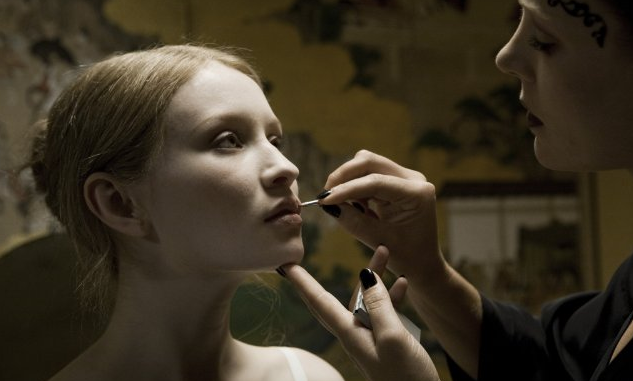
Throughout this film, I was very aware of watching characters on the screen, rather than real people. Knowing that the director, Julia Leigh, is originally a writer, and that this was her first foray into the world of film, I was conscious of wanting to judge it on artistic merit and the believability of the characters.
The opening scenes of ‘Sleeping Beauty’ resembled a fairly typical image of college life, and I felt any connection between myself and the characters stutter and falter in the first half hour. Flicking from scene to scene as if hurrying through the pages of a book – missing out chunks, and being kept at arm’s length from the central character, Lucy – the film began at a fast pace, which didn’t seem well-suited to the style of filming. Even the dialogue didn’t give sufficient time to absorb the meaning and tonal inflection of what was said. Gradually my patience was rewarded though, and it began to find its footing and settled into a smoother progression.
Tantalising, seductive and absorbing, the sets are rich in detail, and the design has a classic, sophisticated feel. Never dipping into anything that I would deem seedy or sordid, unsettling scenes were surprisingly few and far between. Expecting to witness something more shocking, I initially found myself feeling a bit let down by the first elderly gentleman tentatively stroking her skin. The power dynamics were one of the strongest elements of the film, and as discussed in the Q&A afterwards, Lucy’s character is wilful, yet submits to her passive role quite eagerly. The deliberate handing over of her body to others is not about relinquishing power; instead, she seems to revel in her power over men.
The succession of men who visit the Sleeping Beauty Chamber seem to do so for a variety of reasons, ranging from loneliness and wanting to feel human touch again, to a desire to control others and take pleasure from it. In her choice of motives, Leigh attempts to give these characters something we can sympathise with, or identify with parts of ourselves. Undoubtedly striving for something more complex than a basic dichotomy of good versus ‘evil’, she falls short of illustrating the shades of grey in between them. Hidden urges are played out in the privacy of the chamber, and I find it is the more brutal ones which give something for the viewer to rile against. The young are portrayed as naive and the old as uncertain and lost.
I was captivated by a scene in which Lucy stares transfixed by a burning dollar note. There is no destructive emotion here, nor guilt; she seems genuinely intrigued by the fragility of things. Emily Browning has a poise and grace that I found refreshing – her innocent doll-like face seems much better suited (at least superficially) to the role of Lucy, than that of Mia Wasikowska, the original casting choice. Her emotional attachment to Birdmann gives us an insight into her vulnerability, yet for the most part we feel no sympathy for her, as she is a willing victim. Somewhat one-dimensional, Lucy hints at driving forces bubbling below the surface: clutching at a handful of poison berries, her playful nature contrasts with the possessiveness of this act, and her innocent child-like appearance triumphs over anything approaching darker desires.

Leave a Reply